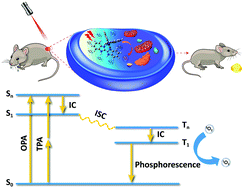Theoretical insight into the photophysical properties of long-lifetime Ir(iii) and Rh(iii) complexes for two-photon photodynamic therapy†
Abstract
Two-photon photodynamic therapy (TP-PDT) plays crucial roles in curing tumors because it involves deep penetration of drugs into the tissue and has minimal damage to the surrounding cells. Our theoretical study was aimed at providing fresh insights into photosensitizers, such as [Ir(N^C)2(N^N)]+ (N^C = 2-phenylpyridine, N^N = bis-benzimidazole) and [Rh(N^C)2(N^N)]+, to treat cancer via the TP-PDT route. To better understand the properties of the complexes [Ir(N^C)2(N^N)]+ and [Rh(N^C)2(N^N)]+, the one-photon and two-photon absorption electronic spectra, energy gap (ΔES–T), strength of two-photon absorption cross-section (δ), spin–orbit matrix element (〈S1|ĤSO|Tj〉), and phosphorescence lifetimes (τ) were calculated by DFT and TD-DFT. The calculation results suggested that both complexes met the criteria (i.e. an efficient ISC process, enough energy to produce 1O2 and phototherapeutic window of the absorption wavelength) of photosensitizers; importantly, the designed complex [Rh(N^C)2(N^N)]+ had better performance than [Ir(N^C)2(N^N)]+, especially in the long-lived triplet excited state. It is expected that our research can make quite a few contributions to the development of photosensitizers and establish some guidelines for experiments based on TP-PDT.



 Please wait while we load your content...
Please wait while we load your content...